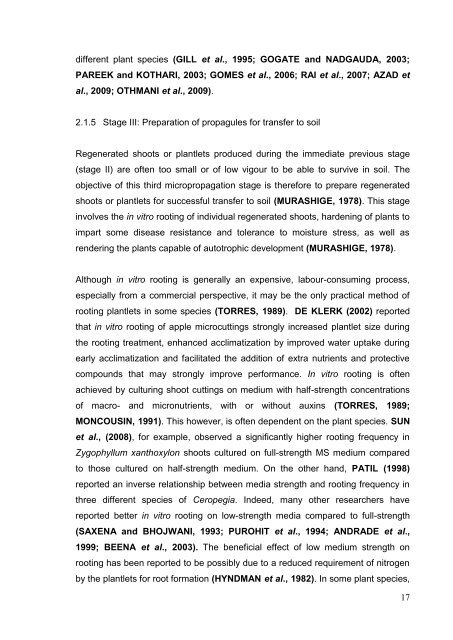Micropropagation and medicinal properties of Barleria greenii
Micropropagation and medicinal properties of Barleria greenii
Micropropagation and medicinal properties of Barleria greenii
Create successful ePaper yourself
Turn your PDF publications into a flip-book with our unique Google optimized e-Paper software.
different plant species (GILL et al., 1995; GOGATE <strong>and</strong> NADGAUDA, 2003;<br />
PAREEK <strong>and</strong> KOTHARI, 2003; GOMES et al., 2006; RAI et al., 2007; AZAD et<br />
al., 2009; OTHMANI et al., 2009).<br />
2.1.5 Stage III: Preparation <strong>of</strong> propagules for transfer to soil<br />
Regenerated shoots or plantlets produced during the immediate previous stage<br />
(stage II) are <strong>of</strong>ten too small or <strong>of</strong> low vigour to be able to survive in soil. The<br />
objective <strong>of</strong> this third micropropagation stage is therefore to prepare regenerated<br />
shoots or plantlets for successful transfer to soil (MURASHIGE, 1978). This stage<br />
involves the in vitro rooting <strong>of</strong> individual regenerated shoots, hardening <strong>of</strong> plants to<br />
impart some disease resistance <strong>and</strong> tolerance to moisture stress, as well as<br />
rendering the plants capable <strong>of</strong> autotrophic development (MURASHIGE, 1978).<br />
Although in vitro rooting is generally an expensive, labour-consuming process,<br />
especially from a commercial perspective, it may be the only practical method <strong>of</strong><br />
rooting plantlets in some species (TORRES, 1989). DE KLERK (2002) reported<br />
that in vitro rooting <strong>of</strong> apple microcuttings strongly increased plantlet size during<br />
the rooting treatment, enhanced acclimatization by improved water uptake during<br />
early acclimatization <strong>and</strong> facilitated the addition <strong>of</strong> extra nutrients <strong>and</strong> protective<br />
compounds that may strongly improve performance. In vitro rooting is <strong>of</strong>ten<br />
achieved by culturing shoot cuttings on medium with half-strength concentrations<br />
<strong>of</strong> macro- <strong>and</strong> micronutrients, with or without auxins (TORRES, 1989;<br />
MONCOUSIN, 1991). This however, is <strong>of</strong>ten dependent on the plant species. SUN<br />
et al., (2008), for example, observed a significantly higher rooting frequency in<br />
Zygophyllum xanthoxylon shoots cultured on full-strength MS medium compared<br />
to those cultured on half-strength medium. On the other h<strong>and</strong>, PATIL (1998)<br />
reported an inverse relationship between media strength <strong>and</strong> rooting frequency in<br />
three different species <strong>of</strong> Ceropegia. Indeed, many other researchers have<br />
reported better in vitro rooting on low-strength media compared to full-strength<br />
(SAXENA <strong>and</strong> BHOJWANI, 1993; PUROHIT et al., 1994; ANDRADE et al.,<br />
1999; BEENA et al., 2003). The beneficial effect <strong>of</strong> low medium strength on<br />
rooting has been reported to be possibly due to a reduced requirement <strong>of</strong> nitrogen<br />
by the plantlets for root formation (HYNDMAN et al., 1982). In some plant species,<br />
17

















